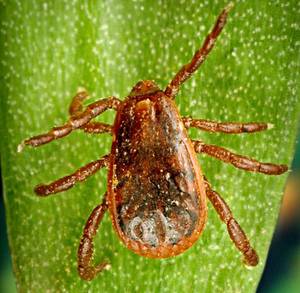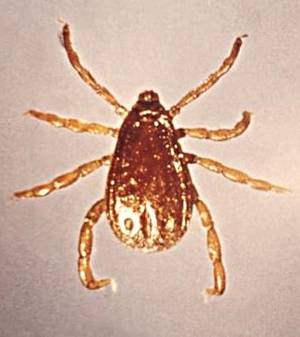Brown Dog Ticks

The Brown Dog Tick (Rhipicephalus sanguineus) occurs throughout continental North America and Hawaii. It is the only species of tick that infests both human dwellings and dog kennels. It appears to be a cold-intolerant parasite and is found only in temperate regions within kennels and homes.
This species is very common in the south-eastern states and the on the west coast. The Brown Dog Tick, or "kennel tick" is one of the most widely-distributed ticks in the world, found in most warm subtropical climates. All of this tick's life stages can be found in the home - they can be found in cracks and crevices in houses, garages, kennels and dog runs, as well as shaded sandy areas in gardens. They are often seen crawling up walls in homes, and can be found in false ceilings.
Brown Dog ticks can also be found outdoors in the southern US at any time of the year, but are only found outdoors in the north during the warmer months. It is generally believed that this tick species cannot survive over winter in the northern US except in buildings with central heating, so the parasite has adapted to living entirely indoors if necessary.
Adult male ticks are flat, about 1/8th of an inch long and uniformly red-brown with tiny pits scattered over their outer shell. Before feeding, adult female ticks resemble the males in size, shape and color, but as they feed, they become engorged with blood and swell to 1/2 an inch long and 1/4 of an inch wide. The legs, mouth parts and shield area behind the head remain red-brown, but the engorged portion of the body turns gray-blue to olive. The red-brown color is distinctive, with no other tick a similar shade.
|
"This tick is very prolific and large infestations can develop quickly in the home."
|
Life for a tick starts as an egg, which hatches to produce a six-legged larvae. This then feeds and molts to an eight-legged nymph which feeds and molts to an eight-legged adult.
The Brown Dog Tick is a three-host tick, but in the US it is almost exclusively feeds on dogs, with all life stages preferring to use dogs as the host. Only on rare occasions do these parasites infest humans or other pets such as cats. In other parts of the world, this tick seems to have a somewhat wider range of hosts.
These parasites do not spread through direct contact. Blood-engorged ticks drop off and molt before they resume host-seeking behavior and attach to another dog.
|
Anti-tick treatments
|
| Pet Shed's most popular solutions for ridding your pet of ticks |
Larvae, nymphs and adults tend to be found in different places on a dog's body. Larvae and nymphs are often found in hair along the back, particularly in the neck region. Adults are found mostly in the ears and between the toes.
After hatching from an egg, the larvae can wait up to eight months before finding a host. Once on the host, the larvae feed for up to a week and then drop off and molt to the nymph stage about one week later. The nymphs then feed for up to nine days, after which they again drop off the host and molt into the adult stage.
Adults can live up to 18 months without feeding, but must find a meal before mating. After mating, the female drops off the host to lay eggs. She may deposit as many as 3000 eggs in sheltered places such as between floorboards, under rugs or carpeting. The eggs usually hatch in about three weeks, although it may take several months in particularly cool or dry conditions. This tick is very prolific and large infestations can develop quickly in the home.

The home should be cleaned as thoroughly as possible, along with the dog's bedding. Treatment of the premises with a tick control pesticide containing allethrin, bendiocarb, carbaryl or permethrin is recommended. It may be advisable to contact a registered pest exterminator for advice. Ensure all people and pets are out of the house during treatment and for the recommended period afterwards, as some of these sprays can be quite toxic.
The Brown Dog Tick can spread the Canine Ehrlichiosis (Ehrlichia canis) and Canine Babesiosis (Babesia canis), diseases, which can cause fever, loss of appetite, lethargy and depression in affected dogs. Babesiosis also causes anemia. However this tick is not an important carrier of human diseases, and has rarely been associated with tick paralysis in dogs.
|
"The Brown Dog Tick can spread the Canine Ehrlichiosis (Ehrlichia canis) and Canine Babesiosis
(Babesia canis), diseases, which can cause fever, loss of appetite, lethargy and depression in
affected dogs."
|
The feeding time required to transmit Ehrlichiosis is not currently known. For Babesiosis, the feeding time to cause an infection is two to three days, but it is still important to inspect dogs daily and immediately remove any ticks found.
Do not touch a tick with your fingers and ensure it is pulled out gently backwards, grasping it as closely as possible to the mouth parts to avoid leaving the head embedded in the animal. You may wish to keep the tick in a sealed jar to help the veterinarian's diagnosis in the event your pet develops signs of a tick-associated disease. If you do suspect such disease, take the pet to your veterinarian as soon as possible. The earlier treatment is started, the better the prognosis.
|
References
|
| Payne, P.A., Dryden, M.W., Carter, G.R. External Parasitic Diseases of
Dogs and Cats. In: A Concise Guide to Infectious and Parasitic Diseases of Dogs and Cats
International Veterinary Information Service, Ithaca NY. www.ivis.org Vredevoe L. Background Information on the Biology of Ticks. Department of Entomology, University of California, Davis. http://entomology.ucdavis.edu What you should know about External Parasites. American Veterinary Medical Association. Schaumberg, IL. www.avma.org Smith, RL. Brown Dog Ticks. Venomous Animals of Arizona. University of Arizona. http://ag.arizona.edu/urbanipm/ticks/browndogticks.html Prevention & Control: Common Ticks. Illinois Department of Public Health. http://www.idph.state.il.us/envhealth/pccommonticks.htm Merck Veterinary Manual. Merck & Co., Inc. Whitehouse Station, NJ, USA, 2006 The Brown Dog Tick Rhipicephalus sanguineus. Tick-borne Diseases Program. Monmouth County Mosquito Extermination Commission. http://www.visitmonmouth.com/mosquito/rhiptick.html |
Frontline� is a registered trademark of Merial